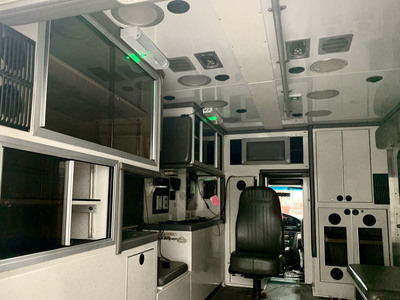Auto Supplier GHSP Debuts Ultra-Violet Light For Emergency Vehicles To Kill Coronavirus
GRAND HAVEN, Michigan – Auto supplier GHSP on Thursday announced it has launched a new line of UV-C treatment products aimed at killing the COVID-19 virus for use in emergency services vehicles.
The ESP200, ESP400, ESS200 and ESS400 are the first products to be launched under the company’s grēnlite brand and bring with them industry firsts for mobile UV-C treatment and safety.
“Using UV-C to kill germs is not a new process, however, deploying it into a mobile space, gathering real-time data and providing the ability to adjust as needed to maximize its efficiency is a major step forward in the use of UV-C.” said Tom Rizzi, Chief Executive Officer of GHSP. “With the challenges our world is currently facing with the COVID-19 pandemic, we’re very pleased that we’re able to bring this technology to the market at this time and help work to minimize the effects of COVID-19 and many other disease-causing germs.”
The new grēnlite units are installable into emergency services vehicles and provide disinfecting through the use of UV-C light that kills 99.9% of all household germs, plus more difficult pathogens such as Clostridium Difficile (C. diff), Streptococcus and COVID-19.
Each model is also connectable to a unique cloud-based monitoring system that not only provides precision control of each unit but is also able to gather information that can be used to increase treatment effectiveness. This industry-first feature is unique to the industry and brings with it the ability to provide additional services such as firmware updates and user adjustment to maximize the UV-C treatment.
in multiple emergency services vehicles from ambulance and medical mobility transporters to police cruisers, the units are configured and installed based on the overall size of the treatment area and several units can be paired and work together to cover all areas of the vehicle from treatment areas to operator compartments.
By employing multiple safety sensors and redundant safeguards, the system has the ability to run anytime safety protocols are met and greatly increase system effectiveness. This feature increases efficacy because doses of UV-C light are accumulative. Meaning, even if a dosing cycle is interrupted, when the system restarts it can continue to complete the cycle without the need to start over. Receiving multiple short doses throughout the day, even while the vehicle is in use, is proven to be more effective than a major cleaning cycle that is run during vehicle downtime. No longer does a vehicle need to wait until the end of a shift to be cleaned. Vehicles can now utilize a continual cleaning approach, even while in-service and greatly improve results.




